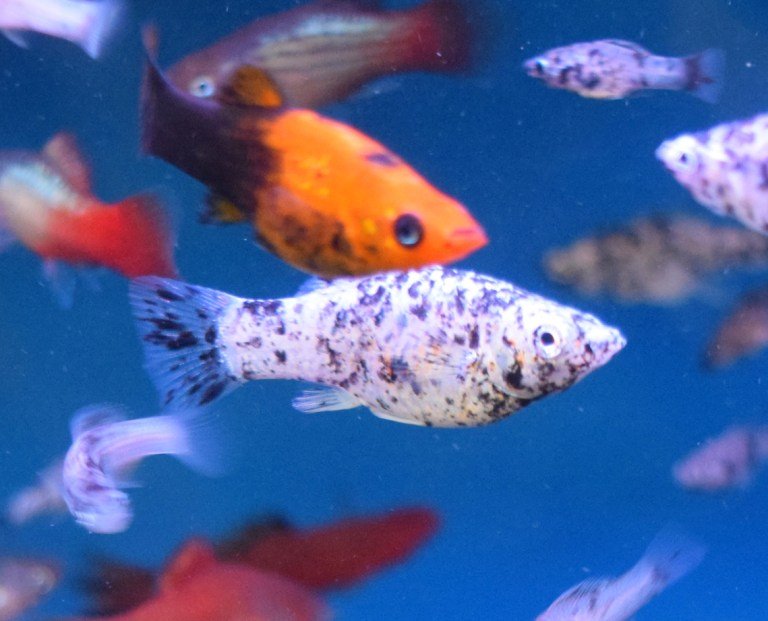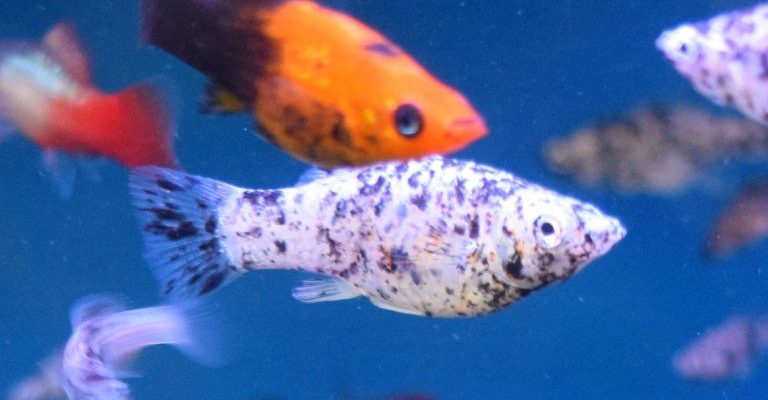
Think of your molly fish as little underwater personalities. They have their moods, habits, and even social dynamics. Whether they’re darting around the tank, hanging out by the plants, or sometimes just floating lazily, each action can provide insight into how they’re feeling. Let’s dive into the fascinating behaviors of molly fish and what they can mean for their well-being.
Types of Molly Fish and Their General Behavior
Molly fish come in different types, including the Black Molly, Sailfin Molly, and Dalmatian Molly. Each type has its own unique characteristics, but they all share common behavioral traits that can give you clues about their health.
For instance, Black Mollies are known for being quite social. They often swim in schools and enjoy interacting with other fish. On the other hand, Sailfin Mollies are more laid-back but can display aggression if they feel threatened. It’s essential to observe how your specific type of molly interacts with others to understand what’s normal behavior for them.
Here’s the thing: all mollies thrive in a peaceful environment where they feel safe. If you notice any signs of stress, it might be time to reassess the tank’s conditions or the type of tank mates you have. Healthy molly fish are active swimmers and love to explore their surroundings, so keep an eye out for any changes in their activity levels.
Common Molly Fish Behaviors
Molly fish exhibit a range of behaviors that can indicate their mood or health. Here are some common behaviors and what they might mean:
- Swimming Patterns: Active swimming is a sign of a healthy fish. If your molly is darting around the tank, it’s likely feeling good and is comfortable in its environment.
- Hiding: If your molly hides frequently, it could be feeling stressed or threatened. Make sure there are plenty of hiding spots, like plants or decorations, to help them feel secure.
- Fighting: Male mollies can sometimes be aggressive towards each other, especially during mating season. Keep an eye on their interactions and separate any that show signs of bullying.
- Breeding Behavior: If you notice a male molly chasing a female, it’s likely he’s trying to court her. This behavior can be exciting, but it’s essential to monitor it so it doesn’t become too aggressive.
Understanding these behaviors can help you create a more suitable environment for your mollies. By recognizing what’s normal for your fish, you can more easily spot when something’s not right.
What To Watch For: Signs of Stress and Illness
Just like us, molly fish can experience stress or illness, and it’s crucial to recognize the signs early. Some common indicators of stress include:
- Faded Color: Vibrant colors usually mean a happy fish. If your molly’s colors are dulling, it could be a sign of stress or illness.
- Erratic Swimming: If your fish is swimming in circles or darting around chaotically, it might be feeling uncomfortable in its environment.
- Gasping at the Surface: If your molly frequently comes to the surface, it might be suffering from low oxygen levels or gill problems.
If you notice any of these signs, it’s a good idea to check the water conditions—make sure the temperature, pH, and ammonia levels are all within the right range. Addressing these issues quickly can help your fish recover before things get worse.
How Social Behavior Affects Molly Fish
Mollies are social creatures and often thrive in groups. They can become stressed or lonely if kept alone. If you’re thinking about starting an aquarium, consider adding more than one molly.
Here’s a fun fact: when molly fish are kept in schools, they often display more vibrant colors and lively behavior. Watching them interact with each other can be quite entertaining. You might see them playfully chasing each other or establishing a little hierarchy within the group.
Keeping a balanced ratio of males to females is also essential. Too many males can lead to aggressive behaviors, while a mix of both genders allows for natural social interactions and breeding.
Diet and Its Impact on Behavior
Believe it or not, what you feed your mollies can also affect their behavior. A balanced diet that includes high-quality flake food, brine shrimp, and vegetables keeps your fish healthy and active. If they’re not getting the right nutrients, you might see a drop in their energy levels and overall activity.
Additionally, overfeeding can lead to bloating and lethargy. Make sure to feed your mollies small amounts a couple of times a day, just enough for them to consume within a few minutes. Remember, a healthy fish is a happy fish, and proper nutrition plays a significant role in their behavior.
Observing Breeding Behavior: What to Expect
If you’ve got a mix of male and female mollies, you might be curious about what breeding looks like. Molly fish can become pregnant quite easily, and their breeding rituals can be fascinating to observe.
During mating, the males will chase the females, displaying vibrant colors to attract them. After the male successfully courts the female, she may become pregnant and eventually give birth to live young. It’s essential to have a separate nursery tank ready if you want to ensure the fry’s survival, as adult mollies might eat them.
Here’s the thing: if you do end up with baby mollies, they can add a whole new dynamic to your tank. Watching them grow and develop can be incredibly rewarding!
Getting to know your molly fish’s behavior is key to providing the best care possible. From observing their swimming patterns to recognizing signs of stress, every little detail helps paint a clearer picture of their health and happiness.
Molly fish are not just beautiful pets; they’re complex little beings that thrive in the right environment. By paying attention to their behaviors and needs, you can create a home where they feel safe and loved. Remember, a happy molly is a colorful and active one, so keep a watchful eye and enjoy the delightful antics of your aquatic companions.

